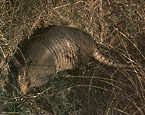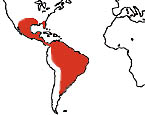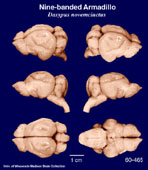|
Nine-banded
Armadillo
(Dasypus novemcinctus) #60-465 |
||||
|
|
Physical
characteristics and distribution
|
|
Its name comes from a Spanish word referring to its armor like covering. The shell is made of a bone like casing. In the Nine-banded Armadillo (the only species of armadillo found in Texas), the armor consists of a large shield over the shoulders, a second large shield over the rump, and nine bands in the middle. Because the shell itself cannot grow nor be replaced as it grows, it is soft and leathery when the Nine-banded Armadillo is born. It does not harden until it reaches its full adult size of 8 to 15 pounds. Walking on the soles of its back feet and the tips of its claws on its front feet, the Nine-banded Armadillo ambles along at no more than a third of a mile per hour. However, it is able to run when danger threatens. Its hard shell allows it to run through thorny underbrush when fleeing predators. The Nine-banded Armadillo has a particularly interesting method for crossing water. Its heavy armor shell causes it to sink. When faced with a narrow stream or a water filled ditch, it will simply walk across the bottom, under water. However, when up against a wider body of water, the armadillo will swallow enough air to inflate its stomach to twice its normal size. This increased buoyancy then allows it to swim across. Afterwards, it takes several hours to release all the excess air from its body. Like its cousin the anteater, the armadillos love to feast on ants. It's fond of all kinds of bugs, particularly larval and adult scarab beetles. The Nine-banded Armadillo has a keen sense of smell and can sniff out a tasty meal six inches underground. When digging for grubs, worms, and other goodies, it leaves behind three to four inch cone shaped holes. It regularly revisits these holes to gobble up any new bugs or snails which may have slipped in. Its sticky, barbed tongue aids it in picking up its food. It is also known to feed on carrion, with a distinct preference for the maggots it finds there. It has 30 to 32 teeth, all of them peg shaped molars. Its shell provides insulation little insulation for its warm blooded body. In the summer, it does most of its foraging in the cool of the evening and at night. Outside of the breeding season, adult Nine-banded Armadillos generally live alone. It may have up to 15 burrows (each eight inches in diameter and two to twenty five feet long) in its 10 acre range. Some burrows have several entrances for emergency access, but there is always a main entrance which it uses most of the time. A Nine-banded Armadillo always bears an identical set of quadruplets, conceived from a single fertilized egg. The initial embryo divides in two and those two embryos divide, in turn, into two more. Thus every Nine-banded Armadillo is a clone of its three brothers or its three sisters. A distant counsin of the sloth and the anteater, the Nine-banded Armadillo originated in South America. It immigrated to Texas by way of Mexico in the 19th century. Its distribution today is S USA, Mexico, Central and South America of N Argentina, the Lesser Antilles (Grenada), and Trinidad and Tobago. |
|
Description
of the brain
|
|
Animal
source and preparation
|
|
All specimens collected followed the same preparation and histological procedure.
|
Other Related Resources (websites and publications)
List of Specimens | Explore Collections | Brain Sections | Brain Evolution | Brain Development | Brain Circuitry | Brain Functions | Location and Use | Related Web Sites | Contact Us | Search MSU Database | Personnel | Home



